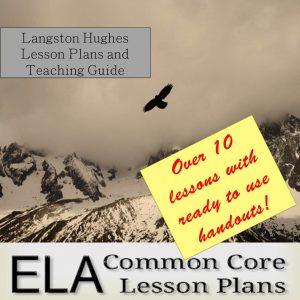How to do a Poetry Analysis

Imagine having 11 complete poetry units with handouts and lesson plans completed. You don’t need to imagine. These units are teacher ready and student ready. Just print, make copies, and accept accolades from colleagues and students.
Before we get to our analysis of “Dreams” and “What Happens to a Dream Deferred?” let’s review the steps for doing a poetry analysis.
1. Print out the poem. Most poems can be found online. If you have a book you’re allowed to write in, then write in it.
2. Annotate the poem using the following steps:
- identify the rhyme scheme
- identify the meter and any examples of straying from the meter
- if the poem is difficult, summarize each stanza
- circle important words, ambiguous words, and words you need to look up
- circle examples of figurative language
- write questions
- write down insights.
3. Draw conclusions based on the information you gathered while annotating.
4. Write the poem analysis. The following steps are for how to write a paragraph analysis:
- The topic sentence should state the poem’s theme (one that may not be so obvious).
- The examples, facts, citations from the poem you’re analyzing should support your topic sentence.
- Provide analysis explaining how your facts support your topic sentence.
5. Impress your friends and neighbors with a brilliant poem analysis.
An Analysis of “Dreams” by Langston Hughes
Hold fast to dreams (x)
For if dreams die (a) (personification)
Life is a broken-winged bird (x) (metaphor)
That cannot fly. (a)Hold fast to dreams (x)
For when dreams go (a) (personification)
Life is a barren field (x) (metaphor)
Frozen with snow. (a)
- The rhyme scheme is labeled above. The rhymes connect lines 2 and 4 of each stanza, ironically rhymes that contrast each other, rhymes that could have coincided if dreams were held fast as the poet exhorts. The rhyme is broken up by unrhymed lines. Form reflects content. The broken rhymes may represent the broken lives of a dreamless life.
- There is no set meter or set form. The poem shapes itself like a dream. Form reflects content.
- The word "fast" in the first line of each stanza puts emphasis on the need to fasten oneself to his or her dreams. It should not be a casual relationship.
- The repetition of the first line of each stanza emphasizes this need even more.
- The structure of each stanza is the same. Each begins with the same exhortation followed by stark images of what happens if that exhortation is ignored.
- The word "dreams" is personified. The life of dreams stands in contrast to the death images that follow.
- It's the figurative language that gives the poem power. The personification and imagery has been alluded to. Each stanza contains a metaphor. The first stanza compares a life without dreams to a "broken-winged bird." A broken-winged bird's life has no purpose, much in the same way a life without dreams has no purpose. The second stanza compares a life without dreams to a "barren field frozen with snow." A field is created for the purpose of providing life. A barren field does not fulfill its purpose. A life is created to give and provide life to others. A life without dreams does nothing.
- Other examples of poetic devices include hyperbole insomuch that "a broken-winged bird / That cannot fly" is redundant. The last line of the first stanza is unnecessary other than to accentuate the uselessness of the bird. In addition, if a field is "frozen with snow," it is obviously barren. Emphasis noted.
- If I were writing a poetry analysis, I would begin with the poem's theme: (1) In "Dreams" Langston Hughes uses figurative language to stress the importance of having dreams; or (2) In "Dreams" Langston Hughes uses metaphors to show how miserable a life without dreams becomes; or (3) In "Dreams" Langston Hughes uses personification and imagery to contrast a life with dreams and a life without dreams.
An Analysis of "What Happens to a Dream Deferred" by Langston Hughes
What happens to a dream deferred?
Does it dry up (x)
like a raisin in the sun? (a)
Or fester like a sore-- (x)
And then run? (a)
Does it stink like rotten meat? (b)
Or crust and sugar over-- (x)
like a syrupy sweet? (b)
Maybe it just sags (x)
like a heavy load. (c)
Or does it explode? (c)
- The rhyme scheme is labeled above. The lines ending the questions rhyme as do the last two lines. The end rhyming of the question along with the punctuation add emphasis and forces a subconscious pause, evoking thought. The poem's speaker wants the reader to think about the questions. The dashes interrupt the flow intimating that the speaker is also pondering and not quite sure where the deferred dreams are headed. Note that there is no dash in the last three lines as the deferred dreamer does what only he can, cause violence.
- "Deferred" means delayed or postponed.
- There is no set meter or form, much like a dream. Form reflects content.
- Alliteration examples are highlighted in red above. The repetition of the 's' sound in "sugar" and "syrupy sweet" lends sluggishness and negativity to things that are normally considered cheery.
- Images include dried up raisins, festering sores, rotting meat, crusting sugar, and heavy loads. These images are passive. The subject in each one is doing nothing, just letting the natural course of rotting to take effect.
- The predominant literary device used in this poem is simile. Note that the images using similes are passive images. A simile is an indirect comparison. The only comparison using a metaphor, a direct comparison, is the exploding dream, a violent image contrasting the passivity of the other images.
- Langston Hughes was a primary member in a literary movement known as the Harlem Renaissance. Hughes and other Harlem Renaissance writers sought to express the spirit of black America.
- If I were writing a poetry analysis, I would begin with the poem's theme: In 'What Happens to a Dream Deferred" Langston Hughes uses imagery and figurative language to show how an oppressed people can turn from passivity to violence if not allowed to pursue their God-given rights.
Last Updated on February 26, 2018 by Trenton Lorcher

